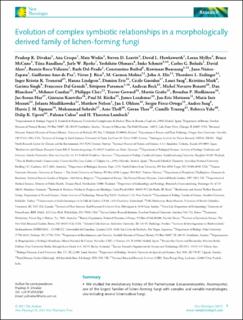Evolution of complex symbiotic relationships in a morphologically derived family of lichen-forming fungi
| dc.contributor.author | Divakar, Pradeep K. | |
| dc.contributor.author | Crespo, Ana | |
| dc.contributor.author | Wedin, Mats | |
| dc.contributor.author | Leavitt, Steven D. | |
| dc.contributor.author | Hawksworth, David L. | |
| dc.contributor.author | Myllys, Leena | |
| dc.contributor.author | McCune, Bruce | |
| dc.contributor.author | Randlane, Tiina | |
| dc.contributor.author | Bjerke, Jarle W. | |
| dc.contributor.author | Ohmura, Yoshihito | |
| dc.contributor.author | Schmitt, Imke | |
| dc.contributor.author | Boluda, Carlos G. | |
| dc.contributor.author | Alors, David | |
| dc.contributor.author | Roca-Valiente, Beatriz | |
| dc.contributor.author | Del-Prado, Ruth | |
| dc.contributor.author | Ruibal, Constantino | |
| dc.contributor.author | Buaruang, Kawinnat | |
| dc.contributor.author | Núñez-Zapata, Jano | |
| dc.contributor.author | de Paz, Guillermo Amo | |
| dc.contributor.author | Rico, Victor J. | |
| dc.contributor.author | Molina, M. Carmen | |
| dc.contributor.author | Elix, John A. | |
| dc.contributor.author | Esslinger, Theodore L. | |
| dc.contributor.author | Tronstad, Inger Kristin Kolstø | |
| dc.contributor.author | Lindgen, Hanna | |
| dc.contributor.author | Ertz, Damien | |
| dc.contributor.author | Gueidan, Cécile | |
| dc.contributor.author | Saag, Lauri | |
| dc.contributor.author | Mark, Kristiina | |
| dc.contributor.author | Singh, Garima | |
| dc.contributor.author | Dal Grande, Fransesco | |
| dc.contributor.author | Parnmen, Sittiporn | |
| dc.contributor.author | Beck, Andreas | |
| dc.contributor.author | Benatti, Michel Navarro | |
| dc.contributor.author | Blanchon, Dan | |
| dc.contributor.author | Candan, Mehmet | |
| dc.contributor.author | Clerc, Philippe | |
| dc.contributor.author | Goward, Trevor | |
| dc.contributor.author | Grube, Martin | |
| dc.contributor.author | Hodkinson, Brendan P. | |
| dc.contributor.author | Hur, Jae-Seoun | |
| dc.contributor.author | Kantvilas, Gintaras | |
| dc.contributor.author | Kirika, Paul M. | |
| dc.contributor.author | Lendemer, James | |
| dc.contributor.author | Mattsson, Jan-Eric | |
| dc.contributor.author | Messuti, Maria Ines | |
| dc.contributor.author | Miadlikowska, Jolanta | |
| dc.contributor.author | Nelsen, Matthew P. | |
| dc.contributor.author | Ohlson, Jan I. | |
| dc.contributor.author | Pérez-Ortega, Sergio | |
| dc.contributor.author | Saag, Andres | |
| dc.contributor.author | Sipman, Harrie J.M. | |
| dc.contributor.author | Sohrabi, Mohammad | |
| dc.contributor.author | Thell, Arne | |
| dc.contributor.author | Thor, Göran | |
| dc.contributor.author | Truong, Camille | |
| dc.contributor.author | Yahr, Rebecca | |
| dc.contributor.author | Upreti, Dalip K. | |
| dc.contributor.author | Cubas, Paloma | |
| dc.contributor.author | Lumbsch, H. Thorsten | |
| dc.date.accessioned | 2023-07-06T11:53:57Z | |
| dc.date.available | 2023-07-06T11:53:57Z | |
| dc.date.created | 2015-08-28T15:15:19Z | |
| dc.date.issued | 2015 | |
| dc.identifier.citation | New Phytologist. 2015, 208 (4), 1217-1226. | en_US |
| dc.identifier.issn | 0028-646X | |
| dc.identifier.uri | https://hdl.handle.net/11250/3076595 | |
| dc.description.abstract | We studied the evolutionary history of the Parmeliaceae (Lecanoromycetes, Ascomycota),one of the largest families of lichen-forming fungi with complex and variable morphologies,also including several lichenicolous fungi. We assembled a six-locus data set including nuclear, mitochondrial and low-copy protein-coding genes from 293 operational taxonomic units (OTUs). The lichenicolous lifestyle originated independently three times in lichenized ancestorswithin Parmeliaceae, and a new generic name is introduced for one of these fungi. In all cases,the independent origins occurredc. 24 million yr ago. Further, we show that the Paleocene,Eocene and Oligocene were key periods when diversification of major lineages within Parmeli-aceae occurred, with subsequent radiations occurring primarily during the Oligocene andMiocene. Our phylogenetic hypothesis supports the independent origin of lichenicolous fungi associ-ated with climatic shifts at the Oligocene–Miocene boundary. Moreover, diversification burstsat different times may be crucial factors driving the diversification of Parmeliaceae. Addition-ally, our study provides novel insight into evolutionary relationships in this large and diversefamily of lichen-forming ascomycetes. ancestral characterreconstruction, Ascomycota, lichenicolousfungi, mutualism, Parmeliaceae, phylogeny, Raesaenenia | en_US |
| dc.language.iso | eng | en_US |
| dc.rights | Navngivelse 4.0 Internasjonal | * |
| dc.rights.uri | http://creativecommons.org/licenses/by/4.0/deed.no | * |
| dc.title | Evolution of complex symbiotic relationships in a morphologically derived family of lichen-forming fungi | en_US |
| dc.type | Peer reviewed | en_US |
| dc.type | Journal article | en_US |
| dc.description.version | publishedVersion | en_US |
| dc.rights.holder | © 2015 The Authors | en_US |
| dc.source.pagenumber | 1217-1226 | en_US |
| dc.source.volume | 208 | en_US |
| dc.source.journal | New Phytologist | en_US |
| dc.source.issue | 4 | en_US |
| dc.identifier.doi | 10.1111/nph.13553 | |
| dc.identifier.cristin | 1260634 | |
| cristin.unitcode | 7511,4,0,0 | |
| cristin.unitname | Tromsø | |
| cristin.ispublished | true | |
| cristin.fulltext | original | |
| cristin.qualitycode | 2 |
Tilhørende fil(er)
Denne innførselen finnes i følgende samling(er)
-
Publikasjoner fra CRIStin - NINA [2397]
-
Scientific publications [1423]
Vitenskapelige artikler, kapitler og monografier i Open Access.

